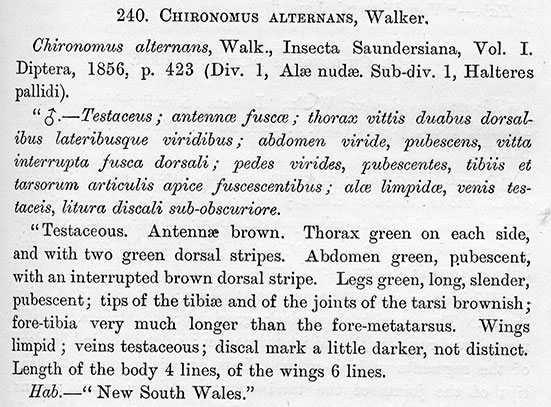C. alternans Walker, 1856Currently a doubtful species
Walker's description of C. alternans, with the translation by Skuse 1889This specimen is in the British Museum of Natural History. To the above description can be added:
Head - Face yellow, palps and antennae brownish. AR about 3.05, Palps (µm): 200? : 73 : 252 : 263 : 431. Frontal tubercles 37 x 15 µm. Clypeal setae 31.
Thorax green yellow, vittae, postnotum and sternopleuron brown. Length abt. 1.84 mm, width about 0.94 mm, depth about 1.68 mm.
Setae - Acrostichals at least 7; Dorsolaterals 15 in 2 rows; Prealar 5,7; Supraalar 1; Scutellar ant. row 4, post. row 12.
Pronotum broad, apically tapered, then abruptly widened at the apex, anteriorly with a broad notch. Mesonotum with a barely discernable median tubercle.
Wing length 4.36 mm; width 0.94 mm; VR 1.0.; SCf on brachiolum 3.
R4+5 ends level with M; R2+3 evanescent at tip, ending at 0.25 of the distance between the apex of R1 and R4+5; Anal ends distal to f-Cu at 0.77 of the distance between f-Cu and apex of Cu2; anal lobe well developed, right angled; squama fully fringed.
Halteres yellowish, width 205 µm.
Legs yellow, tarsi becoming brown. Lengths (microns) and proportions as follows:
| Fe
| Ti
| Ta1
| Ta2
| Ta3
| PI
| 1600
| 1440
| -
| -
| -
| PII
| 1720
| 1580
| 980
| 520
| 380
| PIII
| 1860
| 1940
| 1380
| 760
| 580
|
| Ta4
| Ta5
| LR
| F/T
| BR
| PI
| -
| -
| -
| 1.11
| -
| PII
| 240
| 160
| 0.62
| 1.09
| -
| PIII
| 360
| 240
| 0.71
| 0.96
| -
| Abdomen green with dark saddle spots on tergites II-V, then all dark.
Genitalia missing.Type locality: New South Wales Morphologically very similar to a number of other described species, some unplaced and put as synonyms by Freeman (1961), others grouped as the C. alternans-group. [ Return to Index | Go to Synonyms |
